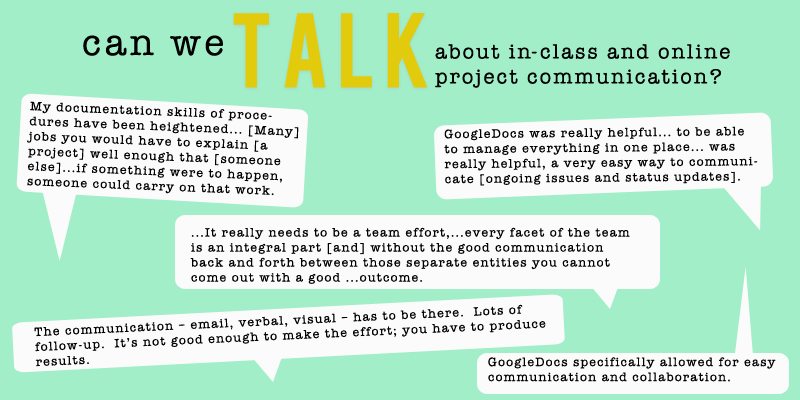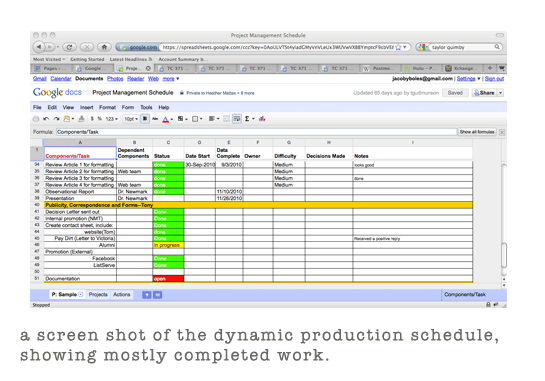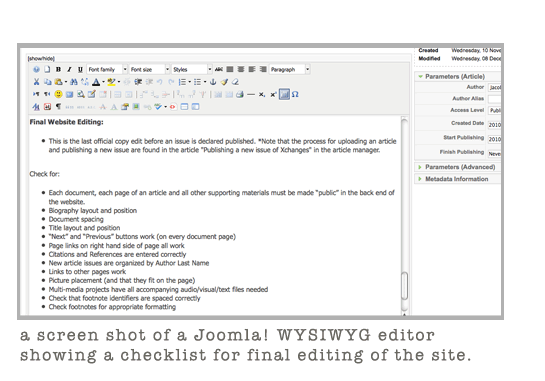

Not only was our project a scholarly e-journal housed within a Technical Communication class, it was the practice of communicating between ourselves and to our audience. The above quotes are our responses to the question of how we communicated with each other and the emerging realization of just how important the communication process is to creating a successful project. This may seem like a fairly mundane realization, but it is an important lesson to be learned earlier rather than later. The realization of using effective communication as a production tool is significant since in this context the communication that fostered the process happened as students took on roles as teachers and managers of their fellow students. The quotes below not only directly address the students’ revelations regarding how best to communicate with their fellow students (through tools like GoogleDocs and email) but also how best to communicate in small groups and within meeting settings. The discovery and implementation of GoogleDocs as a collaborative environment that allowed for document sharing as well as communicating messages was a revelation that allowed for our work to take on a new level of efficiency and efficacy. We decided to implement a web content management system, Joomla!, to manage the articles and files for the website, which established another separate workspace or zone of our project. This further partitioning of our teams’ focus made the usefulness of centralized communication and status reports in GoogleDocs spreadsheets more apparent and necessary.
Time-management and delegation of duties – very important. As well as communication between different groups. GoogleDocs specifically allowed for easy communication and collaboration.
Just report production, how to get a really good piece. Forming something is definitely a team effort. Production should be a group effort, a very important task within an organization.
The course prepared me to work in a complex self-paced collaborative environment. Many tasks needed to be accomplished simultaneously without direct and constant supervision.
There’s a lot more groundwork that needs to be done with respect to the management and organizational side than I realized before. I thought that if you get a project, you start working on it, but there’s definitely work that needs to be done before you can start working on the project, getting things set up so it will run as smoothly as possible. GoogleDocs was really helpful, just to be able to manage everything in one place and the one worksheet that had all of the problems with the website and people could check them as we go and review them, was really helpful, a very easy way to communicate for something like that at least.
The managing processes between groups on a project and between individual team members being able to get everyone on the same page. We had a good team in terms with our goals…so we didn’t have much conflict. Ultimately, the person designated with that task would make the final decision. Communication was sometimes lacking, but not too bad. (No territory battle) Everyone would give input, but I liked that – [and then] I could go back and edit Joomla! [on my own.] But it was nice that we were working at separate ends so we wouldn’t overwrite each other’s work.
The course required students to divide up into three teams, with each responsible for a major undertaking of the journal: Editing and Document Management Team, Correspondence and Promotion Team, and the Website Update Team.
The class met in a room, the newly redesigned Technical Communication lab, which had computer stations for all the students as well as a meeting area with larger monitors for sharing progress and giving presentations. Prior to the major work of the website update, each individual in the class collected information for a recommendation report on the status of the journal and best courses of action for its future.
The teams communicated their progress and work via a spreadsheet in Google Documents. 

The members of the class had varied experiences communicating with their individual teams; however, the central clearinghouse for information was our in-class meetings which highlighted the ongoing communication present on GoogleDocs.
The experience of using a collaborative document tool like GoogleDocs helped the teams and the entire group establish a common ground for making decisions. We also became reliant upon having documented histories of our progress available online to confirm.
As part of the writing component of this course, our recommendation reports were a documentation tool used in change management of the website.
After the recommendations were received, it was decided to move the site into the Joomla! content management system. This system became a place where the work of the three teams merged into the common goal of producing the issue, as well as documenting procedures and best practices for sustaining the journal.
The final website maintained elements from the previous incarnations of the site, as well as the new Joomla!-based navigation and search functions. The administrative side of the website allows different levels of users and contains manuals and guides for each function of the production staff. The benefit of having a content management system in place is that it provides a framework with documented instructions for updating the site. It also gave us, the students, an audience for our documentation of procedures and best practices: our future colleagues who will be maintaining the journal. This further expanded the role of “student as teacher” since we needed not only to communicate with our teams and project group but also to develop strategies for communicating with the future staff of the journal.
-
Categories
- No categories
-
Articles
-
Calendar
April 2024 M T W T F S S 1 2 3 4 5 6 7 8 9 10 11 12 13 14 15 16 17 18 19 20 21 22 23 24 25 26 27 28 29 30 -
Meta
